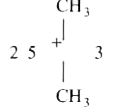Soaps are sodium or potassium salt of long chain fatty acids like
Palmitic acid
Oleic acid
Stearic acid
All of these
The correct Answer is:D
Step-by-Step Solution:
1. Understanding Soaps: Soaps are made from the saponification process, which involves the reaction of a fat or oil with a strong base. The result is a salt of a fatty acid.
2. Identifying the Components: The primary components of soaps are long-chain fatty acids. These fatty acids typically have a carbon chain length of 12 to 18 carbon atoms.
3. Types of Soaps: The two most common types of soaps are sodium soaps (which are solid) and potassium soaps (which are liquid). Sodium soaps are formed when sodium hydroxide is used, while potassium soaps are formed with potassium hydroxide.
4. Examples of Long-Chain Fatty Acids: Common long-chain fatty acids used in soap making include stearic acid (C18), palmitic acid (C16), and oleic acid (C18:1). These fatty acids are derived from natural oils and fats.
5. Conclusion: Therefore, soaps are sodium or potassium salts of long-chain fatty acids such as stearic acid, palmitic acid, and oleic acid.
Topper's Solved these Questions
- BOOK - AAKASH INSTITUTE ENGLISHCHAPTER - CHEMISTRY IN EVERYDAY LIFE EXERCISE - Try Yourself6videos
CHEMISTRY IN EVERYDAY LIFE
- BOOK - AAKASH INSTITUTE ENGLISHCHAPTER - CHEMICAL KINETICSEXERCISE - ASSIGNMENT (SECTION D : Assertion - Reason Type Questions)15videos
CHEMICAL KINETICS
- BOOK - AAKASH INSTITUTE ENGLISHCHAPTER - CLASSIFICATION OF ELEMENTS AND PERIODICITY IN PROPERTIESEXERCISE - Assignment (Section - J Aakash Challengers Questions)6videos
CLASSIFICATION OF ELEMENTS AND PERIODICITY IN PROPERTIES
Similar Questions
Knowledge Check
- Question 1 - Select One
Passage-3
Soaps are the detergents used since long. Soaps used for cleansing purpose are sodium or potassium salts of long chain fatty acids such as stearic acid, palmitic acid. These cannot be used with hard water. Synthetic detergents are cleansing agents which have all the properties of soap but which actually do not contain any soap. These can be used both in soft water and hard water as they give foam even in hard water.
Which of the following is called invert soap?ASodium stearateBCetyl trimethyl ammonium bromideCSodium lauryl sulphateDTetraethyl ammonium chloride - Question 2 - Select One
Passage-3
Soaps are the detergents used since long. Soaps used for cleansing purpose are sodium or potassium salts of long chain fatty acids such as stearic acid, palmitic acid. These cannot be used with hard water. Synthetic detergents are cleansing agents which have all the properties of soap but which actually do not contain any soap. These can be used both in soft water and hard water as they give foam even in hard water.
Which is not true for a detergent molecule ?AIt has a non polar organic part and a polar groupBIt has a surface active reagentCIt is a sodium salt of a fatty acidDIt is not easily biodegraded - Question 3 - Select One
Passage-3
Soaps are the detergents used since long. Soaps used for cleansing purpose are sodium or potassium salts of long chain fatty acids such as stearic acid, palmitic acid. These cannot be used with hard water. Synthetic detergents are cleansing agents which have all the properties of soap but which actually do not contain any soap. These can be used both in soft water and hard water as they give foam even in hard water.
Which one of the following is not a surfactant?A BCH3(CH2)4CH2NH2CCH3−(CH2)16CH2OSO−2Na+DOHC−(CH2)4CH2COO−Na+
BCH3(CH2)4CH2NH2CCH3−(CH2)16CH2OSO−2Na+DOHC−(CH2)4CH2COO−Na+

